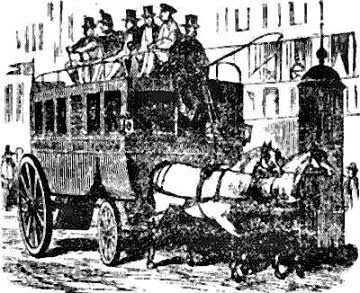OMNIBUS
"Autocarro" (omnibus) de Paris, final do sec. XIX
Fui à procura do significado de "bendy-bus". Previsivelmente, descobri que se tratava de um "autocarro articulado". Mas descobri também várias outras coisas assaz instrutivas:
"The omnibus, the first organized public transport system, may have originated in Nantes, France, in 1826, when Stanislas Baudry, a retired army officer who had built public baths (run from the surplus heat from his flour mill) on the city's edge, set up a short stage line between the center of town and his baths. The service started on the Place du Commerce, outside the hat shop of M. Omnès, who displayed the motto Omnès Omnibus ('Omnès for all') on his shopfront. When Baudry discovered that passengers were just as interested in getting off at intermediate points as in patronizing his baths, he shifted the stage line's focus. His new voiture omnibus ('carriage for all') combined the functions of the hired hackney carriage with the stagecoach that travelled a predetermined route from inn to inn, carrying passengers and mail. His omnibus featured wooden benches that ran down the sides of the vehicle; entry was from the rear.
O primeiro "bus" motorizado do mundo:
uma "carrinha" Benz (Alemanha, 1895)
uma "carrinha" Benz (Alemanha, 1895)
There is also a claim from the UK where in 1824 John Greenwood operated the first "bus route" from Market Street in Manchester to Pendleton in Salford. In 1828, Baudry went to Paris where he founded a company under the name Entreprise générale des omnibus de Paris, while his son Edmond Baudry founded two similar companies in Bordeaux and in Lyons. A London newspaper reported in July 4, 1829 that "the new vehicle, called the omnibus, commenced running this morning from Paddington to the City". This bus service was operated by George Shillibeer. In New York, omnibus service began in the same year, when Abraham Brower, an entrepreneur who had organized volunteer fire companies, established a route along Broadway starting at Bowling Green.

Um "bus" em Cúcuta, Colombia, 1920
Other American cities soon followed suit: Philadelphia in 1831, Boston in 1835 and Baltimore in 1844. In most cases, the city governments granted a private company—generally a small stableman already in the livery or freight-hauling business—an exclusive franchise to operate public coaches along a specified route. In return, the company agreed to maintain certain minimum levels of service—though one of these standards was not upholstery. The New York omnibus quickly moved into the urban consciousness. In 1831, New Yorker Washington Irving remarked of Britain's Reform Act (finally passed in 1832): 'The great reform omnibus moves but slowly'" (mais aqui)
(2008)



1 comment:
I was curious if you ever considered changing the page layout of your website?
Its very well written; I love what youve got to say. But maybe you could a
little more in the way of content so people could connect with
it better. Youve got an awful lot of text for only having one
or two images. Maybe you could space it out better?
Feel free to surf to my site ... dieta disociata
Post a Comment